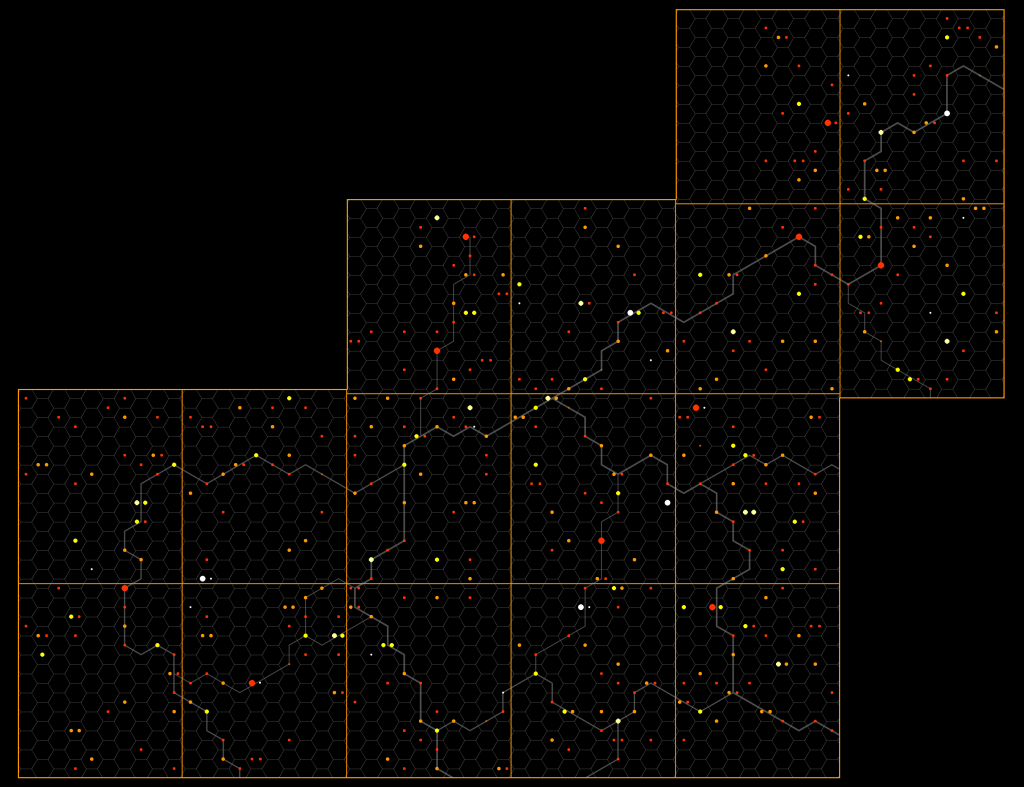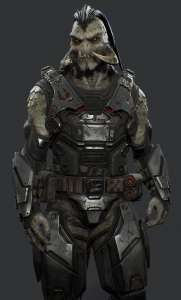Iridium Moons is a retro-futuristic Space Opera setting that first started as an idea somewhere in 2021 after the release of Cyberpunk 2077 and around the time the Dune movie come out. I liked the idea of doing some kind of futuristic neo-noir campaign instead of the fantasy stuff I typically work on but quickly decided that I wanted to create a new setting of my own for that. I’ve been a massive fan of Star Wars since I first saw the movies as a kid, but long felt that the series went off into a rather different stylistic and thematic direction in the 2000s that just doesn’t capture what I still love about the 80s and 90s material. I had long been thinking about how I think Star Wars should have been developed further, and this seemed like the perfect opportunity to get working on a Space Opera setting of my own that takes the best pieces from all my favorite grimy 80s space adventures and stylistically similar work. I’ve been looking into all kinds of different space fantasy and sci-fi series to collect cool ideas that could work well together to create distinctive and evocative style, and ultimately settled on these works as my main style references.
-
- A Princess of Mars (John Carter), 1912
- Dune, 1965
- Star Wars: The Empire Strikes Back, 1980
- Outland, 1981
- Star Trek II: The Wrath of Khan, 1982
- Blade Runner, 1982
- Star Wars: Return of the Jedi, 1983
- Star Trek III: The Search for Spock, 1984
- Star Trek VI: The Undiscovered Country, 1991
- Albion, 1995
- Star Wars: Shadows of the Empire, 1996
- Star Wars: Knights of the Old Republic, 2003
- Star Wars: Knights of the Old Republic, 2006
- Coriolis,2016
- Prey, 2017
I’m a big fan of 1920s Art Deco design, which comes through really strongly in Blade Runner and parts of Mass Effect 2, and with cyberpunk still on my mind, my thoughts drifted to fabulously wealthy and powerful industrial barons who build whole towns for their workers where they also had a monopoly on all services, banana republics whose entire governments were in the pockets of foreign companies, the oil boom, industrial shipyards, labor riots, organized crime, and so on. Which all seems like a really cool setup for a very retro-futuristic Space Opera.
During the early concept phase, I’ve been reading the RPG systems Stars Without Number, Scum and Villainy, and Coriolis. Ultimately my choice landed on Coriolis as the game I want to use for the campaign I am planning, but all three games use different systems to basically represent the same archetypes of a now generic Space Opera setting. The way they approach space travels, star ships, wepons, and mental powers had a big influence on establishing the basic assumptions and parameters of Iridium Moons.
While I see Space Opera as a genre that is inherently fantastical and is really much more fantasy in space than anything that could be called science-fiction, my life-long interest in astronomy and space exploration still makes me think all the time how space fiction gets even simple things completely wrong with no need to do so. My own approach is that I will default to things working and behaving similar to how they do in the real world and did historically, except when the conventions of the genre require completely made up technologies such as hyperspace drives and artificial gravity.
Galactic Society and Demographics
Societies capable of developing and maintining ships for interstellar travel are always highly industrialized and technology advanced, and as such see a stop to population growth or even a decline in population numbers long before they are able to establish colonies in other star systems. With gravity, atmospheric composition and pressure, and solar radiation never being perfect matches to a species’ homeworld, permanently living on a new planet is typically somewhat uncomfortable and causing various health issues for people not adapted to them from childhood. There are always a few people who move to other worlds out of excitement and curiosity, but 99% of all people still live on the original homeworlds of their species.
But with a combined population of some 70 billion across ten species, even just 1% adds up to over 700 million people living on colony worlds and outposts. There are dozens of planets with populations in the tens of millions with several major cities that have become fully independent states in their own right and hundreds of smaller settlements, outposts, and mining sites established by the larger interstellar powers and companies and inhabited by thousands of people. Travel between homeworlds and major colony worlds often takes week or even a few months, and communication between them is only limited and just as slow. While books, movies, and games typically reach even remote systems eventually and create a shared galactic culture, news and messages take such a long time to reach other worlds that most people take little notice of the day to day events in other systems. This also leads to wars between the homeworlds being nearly unthinkable and violent conflicts being very localized affairs.
Space Mining and Industry
All the stars and planets in the universe are made up from the same elements and formed by the same physical processes that create all the different minerals and other molecules found in nature. There is nothing on the billions of planets in the galaxy that can’t already e found in tbe systems of the homeworlds. Whatever food, energy sources, or common technologies a world needs can be found just inside their own system just as well as anywhere else in the universe. However, the way that new planets first form around young stars leads to most of the rarer heavy elements sinking down into the cores, while the upper surfaces of rocky planets are made up of the vastly more common light elements. The only way that many of the heavier elements can be found on the surfae of a planet to be mined is when asteroids that are left over from the formation of the planets crashes into one after the surface has already cooled and become fully solid. This happens often enough that nearly every element can be found in some quantities on almost every planet, but for many critical industrially metals, these amounts are still only a small fraction of the total demand of the homeworlds. The rarity of these metals makes them extremwly valuable, and this in turn makes it worthwhile to journey far across space to planets where pure luck and coincidence led to large amounts ending up in places where they easy to access.
Nearly the entire interstellar economy outside of the homeworld systems exists only for the mining and transportation of rare industrial metals like iridium, palladium, and others. All the people working and living in space are either miners or cargo crews, or providing the supplies and services needed to keep the mining industry running. And even though the interstellar mining industry employs half a billion people on several hundred planets, nearly everything is owned and controlled by a few dozen families of powerful and imeasurably wealthy companies. Less than a hundred people own half of all the wealth that exists outide the home systems.
Nearly all the major interstellar companies are privately owned by the families that founded them, often many centuries ago. With no real government authority existing outside of a few of the largest colony worlds, these industrialist families form an aristocratic elite that controls most mining colonies like feudal lords. In many cases, all the services and businesses on a planet are all owned and controlled by the same family, who rent out housing for their workers and sell all the food and other supplies that can be bought anywhere on the planet. Workers are often lured to leave the homeworlds and take on work in space that pays incredible wages, but all the prices in all of the mining worlds are so high that they live poorer than before and can’t afford to price for a journey back home. Officially almost all the home systems have banned the trade with metals that come from mines that employ outright slave labor, but with cargo containers full of metal that have traveled hundreds of lightyears it is impossible to tell on which planet they were actually dug up and refined.
Hyperspace Travel and Interstellar Communication
The laws of physics dictate that no object or signal can travel through space faster than light. Which means that it will take years or decades to just send a message to even nearby star systems. Fortunately, a hyperspace drive allows a ship to jump through hyperspace where the speed of light is many times fasted than in normal space. A hyperspace jump can cross several lighyears in a day, but it is only possible to enter hyperspace a considerable distance away from the gravitational effects of large masses like planets and especially stars. Typically a ship will have to travel with its regular engines at less than the speed of light for several days to get enough diatance from a star to start its jump, and then several more days to fly from the edge of the new system to the destination planet. Quite often, these journeys at sublight speed take considerably longer than the actual jump through hyperspace between two systems.
With hyperspace being a separate dimension, a ship is completely blind to anything in normal space during a jump. To reach its destination and not end a jump in empty interstellar space, a ship needs to know its exact position and the position of the star that is its destination. Since all stars are constantly moving around their galaxy, their positions are always changing. Even tiny errors in the direction or distance of a jump can lead to a ship appearing months or years away from the star it meant to reach. Only a few deep space exploration ships are equipped to measure the positions, trajectoties, and velocities of nearby stars precise enought to calculate a hyperspace jump. Any other ship must rely on hyperspace charts released by planetary observatories that need to be constantly updated. Since these charts are very expensive to make, they usually cover only stars that would actually see some ship traffic. As a result, ships are restricted to travel along a network of routes between charted planets and can not simply jump to any star that it can see. The precise arrival point after coming out of hyperspace is highly umpredictable and it often takes days for fleets to regroup after a jump and reach the planet they are headed for. This makes surprise attacks from hyperspace against planets and ships impossible.
With ships in hyperspace being completely blind, they can not send or receive any signals. To send a message from one system to another, it needs to be recorded and stored on a ship that makes the jump to the destination system where it can then send the message to a planet or ship with regular communication at lightspeed. Which can still take another several hours to reach the target.
Space Battles and Combat
Missiles are the most efficient weapons to destroy starships, but they are also very easy to spot and track and all warships and even many cargo ships are armed with extremely fast firing railguns that can destroy missles at short range very effectively before they have time to evade the fire. As a result, encounters between warships are primarily fought with very large railguns whose solid projectiles are impossible to shoot down, but which can be quite easily evaded over long distances. A typical battle consists of ships shooting holes into each other from tens of kilometers away until they are damaged enough to destroy them with explosive missiles. Small fighter crafts are useless in such a style of warfare as they can’t carry railguns large enough to do serious damage from far away and are just as easy to shoot down as missiles at close range. While pirates sometimes use small ships with light weapons to force unarmed freighters to surrender their cargo, actual war ships are hundreds of meters in length with thousands of people crewing them.
Railguns are also used widely as weapons by soldiers and security guards, but firearms are also quite common in many poorer places as they are much cheaper to produce and can kill an unarmored person at short range just as well. Handling guns in tight spaces on ships has a lot of problems and it’s pretty much impossible to aim them when being weightless and not having a firm stance on the floor to hold them steady. As a result, people who are expected to fight on starships and space station almost always carry large knives or small swords with them. These also have the advantage of being much easier to conceal in places where weapons are not allowed and security scans for guns. Combat with blades is much more common in space than people on the homeworlds usually think.
Mental Powers
Intuitation is a skill that can be developed over many years through complex mental exercises and the use of various psychoactive drugs. It trains the brain to make greatly increased use of the subconciousness to process information and find the connections between clues and pieces of evidence, as well as perceiving subtle details and reading other people’s emotions to predict their future behavior. The problem with intuitation is that much of the process happens unconsciously and as such even the intuitators don’t usually know or can explain the reasons that led them to their conclusions. While many expert intuitators are highly reliable and have few things get past them without their notice, their inability to share the logic of their conclusions makes acting on their advice always somewhat of a gamble. They make for excelent investigators and interrogators that can spot potential threats earlier than anyone else, but without the ability to proove what they have discovered or to check their reasoning for any flaws, they are rarely employed in positions where they are allowed to make important decisions.
To many people, intuitation is a simple and straighforward technique to process and analyze information at a higher level than ordinary rational thinking. But to many people not familiar with the exact proccesses of how intuitators are trained, their exceptional sense of perception and preduction appears supernatural and disturbing. Many intuitators themselve believe that they are able to catch glimpses of aspects of reality too vast and complex in scope for ordinary minds to even conceive of. Numerous religions have been founded by intuitators claiming to have recieced great revelations about the true nature of reality and large numbers of them are engaged in various traditions of mysticism. But there are of course many people who believe that these are simply delusions caused by the heavy use of psychoactive drugs during their training.

 The New Frontier Survey was one of the largest astrometric survey projects ever undertaken in the history of Known Space and has not been surpassed in the following more than 300 years. A consortium of many of the largest mining companies at the time comissioned the surveying and calculation of hyperspace routs for 16 new sectors, increasing the mapped area of the galaxy by over 5%. Great hopes had been placed on the discovery of significant easy to access resource deposits, and while initial exploration missions to the most promising systems turned out quite promising, the overall commercial success of the project has become widely regarded as somewhat disappointing by the space mining industry.
The New Frontier Survey was one of the largest astrometric survey projects ever undertaken in the history of Known Space and has not been surpassed in the following more than 300 years. A consortium of many of the largest mining companies at the time comissioned the surveying and calculation of hyperspace routs for 16 new sectors, increasing the mapped area of the galaxy by over 5%. Great hopes had been placed on the discovery of significant easy to access resource deposits, and while initial exploration missions to the most promising systems turned out quite promising, the overall commercial success of the project has become widely regarded as somewhat disappointing by the space mining industry. Of all the peoples working and living in interstellar space, the Enkai are the most numerous. They were one of the first civilizations discovered by the Damalin after their rediscovery of hyperspace travel and since then have established dozens of colonies, many of which have by now grown to populations in the tens of millions.
Of all the peoples working and living in interstellar space, the Enkai are the most numerous. They were one of the first civilizations discovered by the Damalin after their rediscovery of hyperspace travel and since then have established dozens of colonies, many of which have by now grown to populations in the tens of millions.


